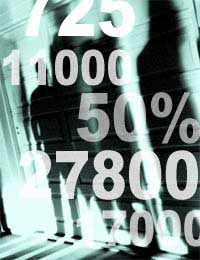Organ Donation: Facts and Figures

Transplant surgery has become much more common in the last 30 years, which has created the universal problem of a shortage of donated organs.
Sourcing Donated Organs
Organs such as the kidney, heart, lung, cornea and liver are obtained from people who have died (non-heart-beating donors) or who are declared clinically brain dead but whose body functions are maintained artificially (heart-beating donors).There was a move away from using any non-heart beating donors as far better survival rates were obtained using organs from people whose blood supply was still active when the organ was removed. Now the growing shortages have led many transplant centres to reconsider. They do not use non-heart beating organ donation where possible to try to overcome some of the shortages. In the UK in 2006 to 2007, over 400 kidneys were obtained from non-heart beating donors for transplantation, an increase of 36% on the previous year.
Living organ donation is also becoming more commonplace. In the same year, even more kidneys were donated by living donors with over 829 people agreeing to give one of their kidneys to save someone else’s life in 2007 to 2008. Living donation now accounts for a third of kidney transplants performed in the UK
An Increasing Demand
In the USA, where transplants have saved over 300 000 people and are now the most common treatment for many diseases as they lead to organ failure, demand outstrips supply several times over. In July 2008, over 76 000 people in the USA were on the waiting list for a kidney transplant but fewer than 17 000 kidney transplants were actually done in the whole of the previous year.Living donors are also used more frequently in the US – over 6000 of the kidney transplants performed were done with living kidneys. Techniques such as dividing a donated liver to give to more than one donor are also practised.
Nevertheless, up to date estimate say that 18 people die in the US and 3 people in the UK each day because they cannot be matched up successfully with a donated organ. In the last decade the number of people awaiting transplants has increased by over 100% and in the USA alone there are now almost 100 000 people on the waiting list for a kidney, heart, lung, liver or pancreas donation.
It is a similar story in Europe where, in 1969, there was a kidney waiting list of only 450 patients and 109 transplants were performed, only 9 of them with organs from living donors. The number of transplants increased exponentially between 1983 and 1998, and now demand seems to have stabilised. The number of transplants has also increased, but has not kept pace with demand. In 2006 just under 12000 people were on the kidney transplant waiting list but fewer than 4500 transplants were performed, almost 1000 of them from living donors.
Organ Donation Systems
The UK has a national organ donation system called the NHS Organ Donor Register. As of the end of March 2008, this had over 15 million organ donors on its database, which accepts about a million extra people each year. However, as organs need to be closely matched to minimise the possibilities of rejection and people only actually donate their organs after their death, there is still an acute shortage.Because of multiple use of organs, the statistics suggest that each person who agrees to donate their organs after death could contribute to life saving procedures for 50 people and completely remove 8 people from the transplant waiting lists.
Of the countries that are now part of Europe, 26 run organ donor programs that are described as opt-out rather than opt-in. This means that people must ask to be registered to prevent their organs being used for donation, rather than explicitly saying they agree to their organs being used. As many people would not mind their organs being used but just never get around to registering, opt-out systems do result in a higher rate of donation. The UK and US systems are still opt-in but there is increasing pressure for change to an opt-out system.


Re: Difference Between a Hospital Ward and Private Room
Do you all not have call buttons? I keep seeing things about nurses being unable to get back to…
Re: Explaining Your Hospital Stay to Young Children
Hi, my husband had pneumonia early in the year. We told the kids (3 and 5 at the time) what was going on…
Re: Difference Between NHS and Private Hospitals
My dad needs a hernia operation. He’s been told there’s no point going private to reduce the waiting time…
Re: Difference Between a Hospital Ward and Private Room
I've just been in Doncaster royal infirmary in an en suite room I found it very good because I was…
Re: Statistics on MRSA and Surgery
I had Lipo at Cosmed in Mexico got MRSA got septic and almost died
Re: Difference Between a Hospital Ward and Private Room
@Brandon - different hospitals would be different prices, as will different rooms. You can contact…
Re: Difference Between a Hospital Ward and Private Room
Would like to know cost London hospital private room am going in for knee replacement and recently…
Re: Questions You May Want to Ask the Surgeon
@Bubby - I hope it's all over now and you realised there was very little to worry about. Best of luck <3 Bridg.
Re: Questions You May Want to Ask the Surgeon
Thank you bridg ,only got till tues , the nerves are getting worse , that's the thing you just don't know what's…
Re: Questions You May Want to Ask the Surgeon
@Bubby - it'll be fine. That's the thing with ops you're more petrified over the anticipation of what's going to…